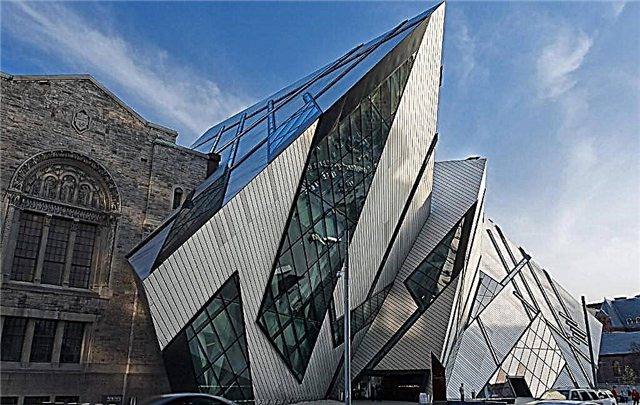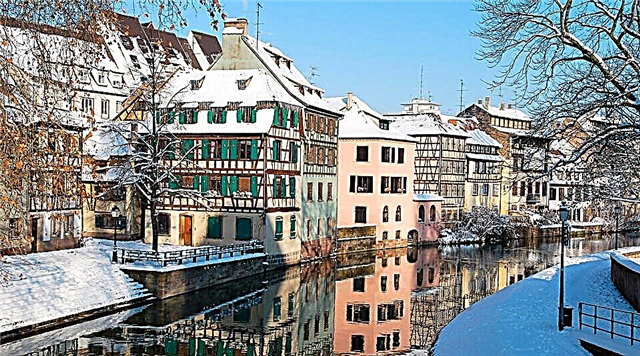Address: France, Paris, street Scribe, 8
Start of construction: 1860 year
Completion of construction: 1875 year
Architect: Charles Garnier
Hall capacity: 1900 people
Main attractions: main staircase, library-museum, large foyer, theater hall
Coordinates: 48 ° 52′19 ″ N, 2 ° 19′54 ″ E
Content:
Short description
You can only get a complete idea of what stunning luxury and splendor, a rich interior and unique architectural forms are in the legendary and world famous Paris Opera.
Now in all tourist brochures and guidebooks to Paris, this huge building is listed as the Opera Garnier. Charles Garnier is a brilliant architect who created the plan according to which the palace was built. “Why a palace?” A person unfamiliar with the architecture of Paris may ask. The point is that all the decoration elements, interior decoration and gigantic dimensions of the theater are characteristic of palaces. These are the palaces in which the kings of France and dignitaries belonging to the great dynasties once lived.
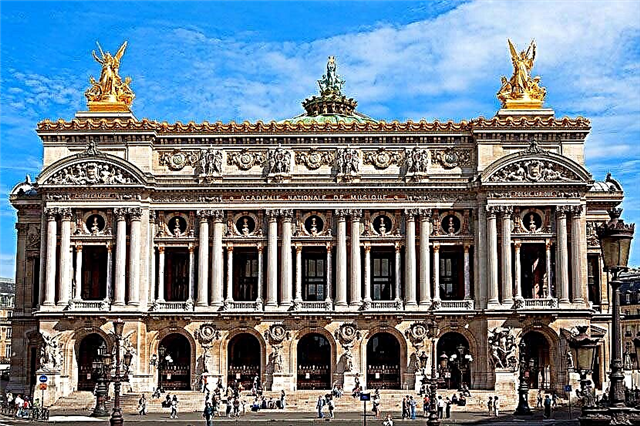
Main south facade of the Opera Garnier
Naturally, Opera Garnier in Paris has never served as a home for a crowned person, no one has ever lived in it (except for the terrible ghost of Eric), the palace was originally built as an opera, in which the performances of the most famous singers were supposed to take place. By the way, almost immediately after its opening, this building, built in the style of luxurious neo-baroque, received the status of the Opera House of the National Academy of Music of France.
All guests of France, without exception, are invited to visit the famous opera, because this building belongs to the most significant sights of Paris. Moreover, the Opera Garnier in Paris is included in the list of the most visited places in the capital of France, along with the Champs Elysees, Versailles, the Pantheon, the Arc de Triomphe and Notre Dame Cathedral. There is nothing surprising in such an interest on the part of travelers to the building of the opera, because it really introduces into a silent shock with its rich interior, a terrible legend and size. For example, it is only in the back rooms of the building built by Charles Garnier that almost any Old World opera house can be placed.
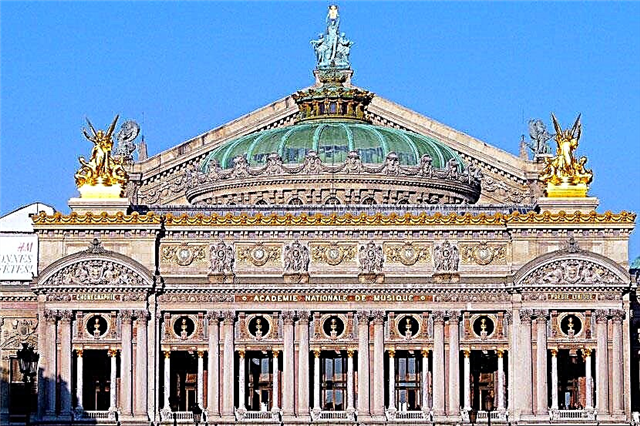
View of the main facade of the opera. Sculptures on the roof of the building, from left to right: Harmony, Apollo, Poetry
In addition, all connoisseurs of opera and ballet book tickets for the performance they are interested in almost a year in advance, because watching the action unfolding on the stage of the most significant and famous theater in the world can be called happiness and great success.
In order to to get to the Opera Garnier, located in the 9th arrondissement of the capital of majestic and wealthy France, it is best to take the metro and get to the stop called "Opera": Driving your rental car in Paris to a building, especially during rush hour, can be a real challenge. When you visit the opera, you should not be intimidated by the terrible ghost of Eric, he is still assigned a special box, from which he watches the performances that are interesting to him.
It is strictly forbidden to stay in the building at night, so a meeting with the otherworldly force is impossible. By the way, the history of the appearance and appearance of the ghost should be discussed in more detail below.
Opera Garnier: construction
The construction of the magnificent palace, which was supposed to be equipped with an opera and ballet theater, began by order of Napoleon III, who forever refused to visit the famous Le Peletier after an unsuccessful attempt on his life.
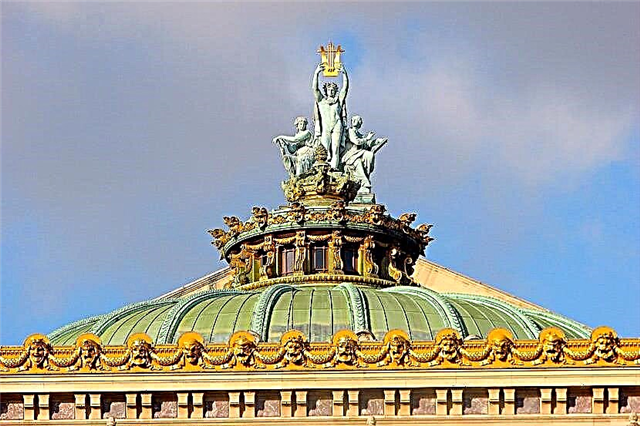
View of the sculpture of Apollo on the roof of the opera
In order to fully satisfy the tastes and requirements of the President of the French Republic, and then the Emperor, a competition was announced among the architects for the best design of the new palace. It should be noted that the future theater of opera and ballet was to become the thirteenth (!) In a row in Paris. Surprisingly, Charles Garnier won this competition, in which the best specialists took part. This architect, who had not yet managed to gain fame, was only 35 years old at that time.
As they say, the first stone in the construction of the building was laid in 1860. The documents contain a rather interesting fact, where it is mentioned that the wife of Napoleon III was interested in the future construction of the palace. She, experiencing genuine interest, once asked her husband: "In what style is the building supposed to be built: in the Greek or in the Roman?" To this question she received a rather unexpected answer: "The new building for opera and ballet, madam, will be built in a new style, in the style of Napoleon III!"
The plans were, as always, grandiose. However, the construction of the Opera Garnier took as long as 15 years! The first reason for such a long construction was the peculiarity of the soil, which in its composition was more like a viscous swamp.

Sculpture Poetry on the roof of the opera
Charles Garnier, despite his age, turned out to be a very hot-tempered and impatient person. Due to numerous failures in laying the foundation, he several times decided to give up the implementation of his project. When the swamp was drained, the architect faced another problem: as it turned out, on the territory where the construction was carried out, there was a giant underground lake. And even in this case, the work was not stopped: for 8 months, giant pumps pumped out water until the volume of the lake allowed the construction of the building to begin.
It seemed that all the difficulties were left behind, but the Franco-Prussian war broke out, during which all the money from the city budget went to the army. In addition, almost immediately after the end of hostilities, the Empire fell, and the French Commune appeared in its place. The revolutionaries had no time for high art: therefore, construction was carried out irregularly, and Garnier had heard more than once that the construction of the palace was about to be completely stopped. It is impossible to imagine the feelings that overwhelmed the architect in those difficult times, who, even when laying the foundation, decided on a feat and made a revolution in architecture and construction at that time. Thanks to the providence from above, on October 29, 1873, the specialist and his construction team received an unexpected order: to complete the construction of the palace as soon as possible.

The north facade of the opera
The reason for this haste was a fire that completely destroyed the Paris Opera, in which at that time the most significant performances were held. In addition, in France, as well as throughout Europe, there is a fashion for the so-called romantic ballet.
Already in December 1874, Charles Garnier reported that the new opera and ballet theater in Paris was almost completely finished. All that remained to be completed was the smoking room and a few utility rooms. By the way, the smoking room was never completed, and nowadays you cannot find it in the legendary Parisian opera Garnier.
The grand opening of the magnificent palace, distinguished by its rich decoration and unique architectural style, took place on January 15, 1875. How could a new opera house be opened with brilliance and noise? Of course, bright performances. The first performances on the stage of the opera Garnier were excerpts from the famous opera "Huguenot" and the third act of "Zhidovka".
The terrible secrets of the opera Garnier
Opera Garnier, despite its popularity among tourists and connoisseurs of high art, is often associated by many with a place full of terrible secrets.
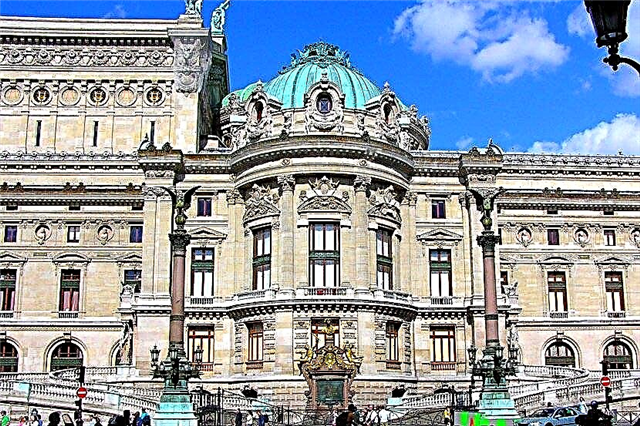
Opera Garnier west facade
The first mysterious incident in the palace took place shortly after its opening: the audience attending the opera Faust suddenly felt that the whole building trembled violently, then the lights in the hall went out completely, and a huge chandelier, weighing just over 800, fell on the concierge (!) kilogram. Many people who are fond of exploring the other world endow the lake under the building with mystical properties. They claim that it is precisely this that is the entrance to the world of the dead. In addition, there are legends according to which hundreds of innocent people were tortured and executed in an unfinished building during the French Revolution. Their souls, according to the assurances of some psychics, to this day cannot find peace for themselves and often appear at night in the form of terrible ghosts to the caretakers of the Opera Garnier.
No matter how many legends go about the palace built in 15 years by Charles Garnier, the most famous, saddest and most terrible is the story of Eric's ghost. Running a little ahead, I would like to note that Eric is a real, not a fictional person, who was born with a congenital facial defect. Because of his ugliness, the talented actor, who played for himself in the cellars of the opera Garnier, was forced to wear a mask so as not to scare away a theater attendant or actor who happened to meet him.

Large foyer
Love ruined the brilliant Eric, his feelings for the dancer Christina Dae remained unanswered. For a long time, he showed her all kinds of signs of attention and patiently waited for the decision of his beloved. At some point, succumbing to an impulse, she agreed to live with a freak in one of the basements, but she could not stand life without spotlights: two weeks later she left the young man in love with her. The grief was inconsolable: Eric removed all supplies of water and food from his home, and of his own free will walled himself up in a dungeon.
Thanks to cinema, this tragic story has spread all over the world: musicals and films about Eric's fate have enjoyed and, by the way, continue to enjoy wild popularity. During excavations, scientists even managed to find the skeleton of an unfortunate lover, who had a clear defect in the bones of the skull. As you know, a suicide cannot find eternal rest. Eric's ghost still wanders around the opera Garnier and is present at some performances... If anyone doubts this story, they should definitely go to the most famous theater in the world. Even today, in the first tier, none of the spectators are allowed to occupy box number 5.
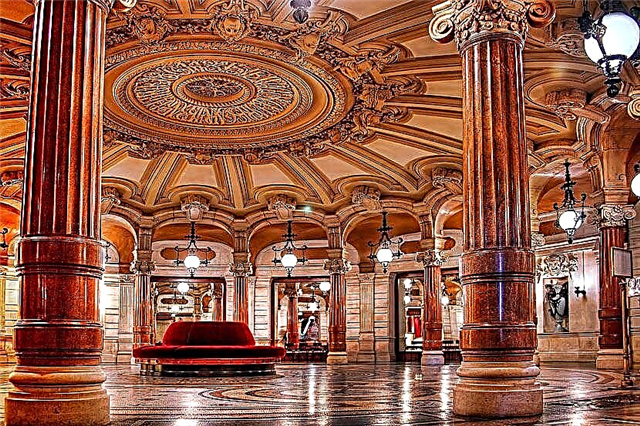
Rotunda of the Sun
This box is for the phantom of the opera. Many may think that this is just an advertisement designed to attract even more visitors to the opera Garnier, but there are facts that after the number 5 box was occupied by spectators, terrible events happened to many of them. The myth is a myth, but hardly anyone, even being an inveterate skeptic, will decide in our age of technological progress to take the place intended for the unfortunate Eric, who, even after his death, could not find peace.
Opera Garnier: a short excursion and a memo to the traveler
You can get to the Opera Garnier without purchasing a ticket for any performance. In any case, you will have to order it in advance. If you plan to visit one of the main sights of the country, with a total area of 21,625 (!) Meters, without a guide, then it is worth remembering that the Garnier Opera is open from 10 am to 5 pm. The ticket costs € 9 for an adult and € 4 for a child. As part of an excursion group, one of the most unique palaces in France can be visited only on Wednesday, Saturday or Sunday. It will be useful to know that the guided tours are in French and English only.
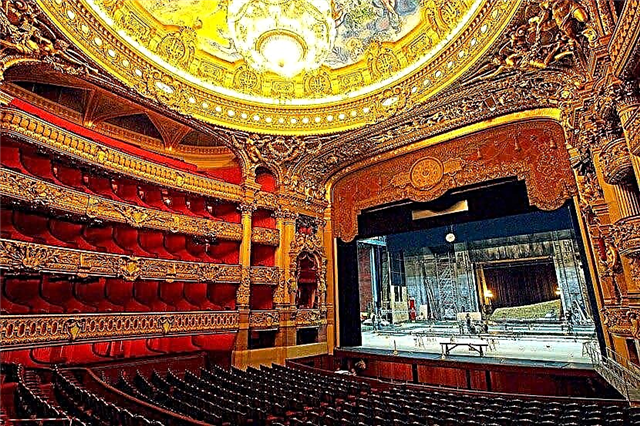
Theater Hall
What to see first of all in the opera Garnier? It will be extremely difficult to answer this question. It is so huge that sometimes it seems impossible to get around it even in a few days. However, special attention should be paid to the stage, which can accommodate about 450 (!) Actors; a giant chandelier weighing 6 (!) tons; a rich interior, a lot of stucco moldings and a ceiling painted by Marc Chagall himself. By the way, there was constant controversy around this huge work of art, under which there is a brightly scarlet auditorium: some critics believed that the work of a genius was not magnificent enough for a building like the Palais Garnier in Paris. The beautifully made bronze busts of the most famous composers: Mozart, Beethoven, Aubert, Halévy and many others will also arouse genuine interest in the guest of the palace. The building itself contains a truly huge number of stairs and corridors, which allow numerous groups to move around the theater without hindrance. It is impossible to imagine the titanic work that Charles Garnier put into his brainchild: according to the architects, all the drawings of the genius, folded one after another, will form a continuous line ... 33 kilometers long!
At the moment, there is reliable information that a monument to the Russian theatrical figure Sergei Diaghilev will be erected in front of Garnier's opera, who organized a troupe called "Russian Ballet" in the capital of France. It will be easy to guess that she performed on the stage of the legendary Opera Garnier in Paris.

Main staircase
Even at the slightest opportunity, the traveler, whom the paths brought to the capital of France, should definitely visit the Opera Garnier. After all, the splendor that can be seen in its auditorium and numerous corridors is no longer found anywhere in the world. The only thing that should be constantly remembered while in the palace is that one should not occupy box number 5 for the sake of bravado or simply out of interest. "He is here, beware of him, because the Phantom of the Opera is coming ..." musical.



